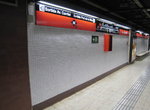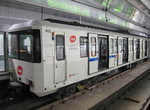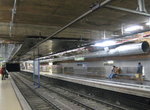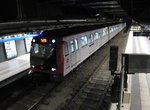Barcelona, Spain
![]()
Line 3 station at Fontana. Photo by Bernard Chatreau, February 2008.
Overview
Barcelona, bilingual (Catalan and Castilian), is the capital of Catalonia, one of the most important cities of the Iberian Peninsula and undoubtedly one of the most well-known of the world. The city does not have extraordinary dimensions (as it only has 1.6 million inhabitants); nevertheless, Barcelona and its adjacent municipalities (including the cities of Montgat, Tiana, Badalona, Santa Coloma de Gramenet, Sant Adrià de Besòs, Montcada i Reixac, Castelldefels, Gavà, Viladecans, Sant Boi de Llobregat, el Prat de Llobregat, l'Hospitalet of Llobregat, Cornellà de Llobregat, Esplugues de Llobregat, Sant Joan Despí, Sant Just Desvern, and Sant Feliu de Llobregat) form a huge urban zone, which has 3.1 million inhabitants. This is Barcelona's Metropolitan Area, which is the nucleus of the Metropolitan Region.
Barcelona's Metro operates in the Metropolitan Area; there are nine metro lines, six (the lines L1, L2, L3, L4, L5 and L11) are exploited by Ferrocarril Metropolità de Barcelona (FMB, owned by Barcelona's City Council) and three (the lines L6, L7 and L8) are exploited by Ferrocarrils de la Generalitat de Catalunya (FGC, owned by the Catalan Government); FMB forms part of Transports Metropolitans de Barcelona (TMB). The network has a length of 104.8 km with 144 stations. The Metro service is complemented by the Tram, a modern tram network exploited by Tramvia Metropolitа (TRAMMET). Moreover, in Barcelona there are also three funicular railways (Montjuïc, Tibidabo, and Vallvidrera) and a vintage tram (the “Blue Tram”), but Tibidabo's Funicular Railway and the “Blue Tram” are generally for tourist use and they are not integrated into the network. The “Blue Tram” and Montjuïc's Funicular Railway are operated by TMB, Vallvidrera's Funicular Railway by FGC and Tibidabo's Funicular Railway is owned by Barcelona's City Council.
Barcelona's Metropolitan Region (with 5.2 milions inhabitants, including the Metropolitan Area) is divided into six fare zones according to the Autoritat del Transport Metropolitа (ATM), which is the public entity that regulates the public transports in Barcelona; the area formed by Barcelona and its adjacent cities (the Metropolitan Area) is the first zone. The rest of FGC lines in Barcelona and Rodalíes Renfe (both are suburban railways), and Renfe itself (one of the companies that operate in the Spanish State network of the Administrador de Infraestructuras Ferroviarias -ADIF-) complete the train services in the Metropolitan Region. Finally, in all this zone there is also a rack railway (Montserrat's) and three more funicular railways (Gelida's, Santa Cova's and Sant Joan's); from these railway systems, only Gelida's Funicular Railway is integrated in the network because the others are tourist. All these special railway systems are operated by FGC.
Metro/Commuter Rail
There are two different track gauges in the Metro ("international" standard and a wider Spanish gauge) so the cars are not interchangable. The stations are all mostly modern concrete looking and mostly undecorated, and nearly all are side platforms. The station platforms have vending machines, signage showing time till next train, and flat panel computer screens with animated advertising and video. There's also piped-in "Muzak" on the platforms.
The FGC suburban station at Placa de Catalunya is quite nice, with 7 or 8 tracks fed by a two track tunnel; the trains turn within minutes serving many northern destinations. There is a small cafe at the head end of the tracks where you can watch the trains arrive and depart. The FGC lines are a cross between a true metro service and a commuter service. There are turnstiles with mag stripe ticketing (same tickets as the Metro lines if you remain within Zone 1). Some of the services, L6 and L7 (formerly the U6 and U7) are somewhat short serving destinations wholly within Zone 1, some services longer to several northern destinations.
Tramvia Blau
At the north end of the FGC line U7, at Avinguda (Avenue) Tibidabo, is the southern terminal of a "heritage" trolley line known as Tramvia Blau, the "Blue Tram" (in 2001, this was the only tramway in Barcelona, but Barcelona's many wide avenues would do quite well with modern LRV light rail and in fact a test track was constructed along Avinguda Diagonal a few years ago for this purpose. Since 2001 several light rail lines have been constructed.) At the terminal there is a single track curbside on the northbound lane of a street. Just north of the terminal it becomes two tracks and runs in the middle (traffic) lane of the road. After crossing a bridge over a motorway, the Tramvia Blau heads up the side of the Tibidabo mountain, still street running, up a steep twisty road. Just before heading up the mountain, a small car barn is down a spur track on a side street.
Funiculars
At the top of the Tramvia Blau tram line is the base station of a funicular, named for the Tibidabo mountain. This is the longest and steepest of Barcelona's three funiculars. It is also running somewhat older cabins than the other two, with manually operated doors and brakes. The cabins look like Volkswagen Microbuses and are painted by local art students (which at first looks like graffiti but looks right at home on vehicles that resemble Microbuses). At the top of the Tibidabo funicular is a "fun fair" (a small amusement park) and a large cathedral overlooking the city of Barcelona. This funicular only runs half-hourly during the off peak season but is only a five minute ride.
Another of Barcelona's funiculars is reached by a short ride on one of the FGC suburban lines to station "Peu de Funicular" and the funicular is known as the Vallvidrera funicular. This funicular also climbs the Tibidabo mountain but is mostly used as a "commuter" funicular for local residents. The FGC train from Placa de Catalunya first emerges from the tunnel and climbs a pretty steep grade up the foothills of Tibidabo. The station of Peu de Funicular is at the mouth of a tunnel through the mountain. The funicular station is up two flights of stairs from the railway platform making it an easy transfer. The tickets to and from Placa de Catalunya allow free transfer to the funicular. The Vallvidrera funicular has recently been upgraded, both the cabins and the operation. The operation is fully automatic, much like an elevator. Unusually, there is a station midway up the mountain just upwards of the midway passing point. To get your cabin to call at this station there is a button inside the cabin like an elevator button. At the station itself there is a call button for "up" or "down" and the proper cabin will stop as it passes by. The platform edges are protected by edge doors which open simultaneously with those of the cabin.
A third funicular climbes Montjuic, a mountain overlooking Barcelona harbor right at the edge of the Mediterranean Sea. Its lower station is inside a long tunnel (which is not very steep for a funicular), and offers transfer to the Metro lines 2 and 3 at Paral.lel station. This funicular's cabins are very large, almost as large as a transit bus, and there are two cabins coupled together. The grades are not that steep until the very top. This funicular is primarily used to reach former Olympics sites, the Fundacion Joan Miro museum, and a military museum located in a fort at the peak.
Tram Lines
Several tram routes opened in Barcelona since 2001.
Route Map

Photo Gallery
| Five Random Images | ||||
 Image 55875 (155k, 1044x788) Photo by: Oscar Urea Location: Cornellà-Centre |  Image 123434 (293k, 1044x788) Photo by: Bernard Chatreau Location: Avinguda Carrilet (L1) |  Image 123535 (282k, 1044x787) Photo by: Bernard Chatreau Location: Can Cuiàs (L11) |  Image 124378 (322k, 1044x788) Photo by: Bernard Chatreau Location: Diagonal (L5) |  Image 124393 (249k, 1044x788) Photo by: Bernard Chatreau Location: Sagrada Família (L5) |
Page Credits
By Òscar Ureña.